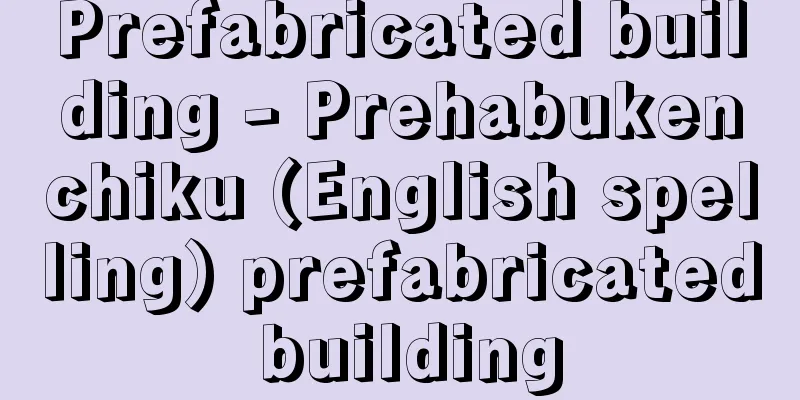Prefabricated building - Prehabukenchiku (English spelling) prefabricated building

|
In a broad sense, it is a general term for buildings that use prefabrication techniques. However, since most buildings are constructed using prefabrication techniques to some extent, when they are called prefabricated buildings and differentiated from other buildings, they refer to buildings that incorporate more prefabricated techniques than conventional buildings. However, buildings that are sold commercially as prefabricated buildings are not necessarily more prefabricated than conventional buildings. [Kiyoshi Kanata] PrefabricationIt is an American term that means prefabricated house component manufacturing. It refers to the process of making components in advance at a different location before assembling the house at the construction site. Specifically, it refers to moving part of the construction work being done on site to another location, such as a factory that specializes in component manufacturing, where the materials are processed and minor assembly is carried out, then transported to the site and installed in the designated location. It refers to one of the means of technological innovation in construction production, such as improving work efficiency, uniformity of product quality, and accuracy, and is usually shortened to "prefab." It is often confused with mass production methods, but even one-off products can be produced prefabricated, and are not necessarily mass-produced. However, mass-produced products will always be prefabricated. [Kiyoshi Kanata] Prefabricated HousesIn Japan, prefabricated housing was developed under the initiative of chemical, steel and other building material manufacturers from 1960 onwards. Initially, they were sold commercially as "assembled housing", and the term "prefabricated housing" is used in contrast to "factory-made housing" that was mainly made of steel, wood or concrete. Steel-framed prefabricated houses use processed lightweight steel sheets (lightweight shaped steel) for the columns and beams, wall panels and fittings made from thin steel sheets or aluminum alloys, and factory-produced panels for the roof and floor structural members, which are assembled on-site. The wall and floor panels also contain built-in piping and wiring for electric lights, telephones, intercoms, and other equipment, including kitchen equipment, unit baths, water supply and sewage systems including sanitary fixtures, and outlets for heating and cooling systems, are all designed and constructed as a single unit. In wooden prefabricated houses, natural wood is used for the main frame, and synthetic wood (laminated lumber) is actively used, and the design is made to give the impression of traditional Japanese wooden houses as much as possible, but the majority of prefabricated houses are made of concrete, produced using the precast concrete method (Precon method). Among them, public housing (mass-produced public housing and precast concrete housing by the Japan Housing Corporation) accounts for a large proportion. In reinforced concrete prefabricated houses, the main structural parts are divided into wall panels and floor panels, precast concrete panels are made for each shape, and assembled on site to form the main structure of a single-family home or apartment building. Compared to regular reinforced concrete buildings, this has the advantage of shortening the construction period. In contrast to concrete prefabricated houses, wooden and steel-framed houses are sometimes called lightweight prefabricated or house prefabricated. [Kiyoshi Kanata] Prefabricated House IndustryA general term for companies engaged in the manufacture and sale of prefabricated houses or their parts, or the business activities of those companies. In Japan, the mass production of lightweight steel was a direct catalyst for the commercialization of prefabricated house production in the early 1960s, and many manufacturers emerged. Ten years later, the industry, including distributors and parts manufacturers, had developed to the point where it was positioned as a central sector of the so-called "housing industry." [Kiyoshi Kanata] Prefabrication of high-rise buildingsIn modern machinery and electronics industries, there are fields where companies can meet demand and increase their profits by continuously mass-producing the same products. Although prefabrication does not directly mean a mass production system, it is used in the production of large-scale buildings such as high-rise buildings to standardize the components of the building as much as possible, and to prefabricate a small number of products with uniform materials and dimensions, simplifying on-site work and preventing omissions, making construction management and operation easier. It also shortens the construction period and increases the profits of construction work. In particular, in large-scale high-rise buildings, the benefits of mass production across multiple manufacturing industries are often enjoyed by standardizing steel frame members, standardizing the design of curtain walls (curtain walls) on the interior and exterior walls, and standardizing the format of auxiliary equipment and lighting fixtures. [Kiyoshi Kanata] Prefabricated frame constructionFrame construction is a method of building buildings with floor and wall panels made of standardized lumber frameworks and surface materials such as structural plywood attached to them, and is popular in North America, including the United States and Canada. The lumber that forms the framework of the panels is standardized with nominal cross-sectional dimensions such as 2 inches by 4 inches (actual dimensions are about 1.5 inches by 3.5 inches, but the JAS regulation is 38 mm by 89 mm) or 2 inches by 6 inches. The lumber with a cross-sectional size of 2 inches by 4 inches, which is particularly widely used in practice, is abbreviated to "2 x 4 (two-by-four)" and is also the origin of the alternative name for this construction method (two-by-four construction). All of these are made from North American fir, hemlock, cedar, and other trees such as Douglas fir (spruce), hemlock, and cedar. The framing materials and the surface panels are mainly joined by nailing with special nails such as stainless steel, and adhesives may also be used in some cases. This construction method was first introduced to Japan in the early 1960s, but since it had been developed in North America, where the climate and environment are different, it was necessary to adapt it to Japan's climate and environment rather than introducing it in its original form. After that, as a result of trial construction and technical research, it became socially established as a prefabricated construction method that contributed to the rationalization of housing production and the rationalization of the distribution system of building materials. In addition, due to revisions to structural regulations for each part in the building administration, it became possible to build three-story buildings using the attic using the frame wall method. [Kiyoshi Kanata] [Reference items] | | | |Source: Shogakukan Encyclopedia Nipponica About Encyclopedia Nipponica Information | Legend |
|
広義にはプレファブリケーション(prefabrication、まえもって製造することの意)の手法を用いた建築物を総称する。ただし、たいていの建築物は多少ともプレファブリケーションの手法を取り入れて建造されているので、プレハブ建築と称してそのほかの建築物と区別する場合には、従来のものよりプレファブリケーションの手法を多く取り入れたものをさす。しかし、プレハブ建築と称して市販されているものが、在来のものに比べてかならずしもプレハブ化が進んでいるとは限らない。 [金多 潔] プレファブリケーションアメリカ語で組立家屋部分品製造のことをいう。家屋を建設現場で組み立てる以前に別の場所で部分品をあらかじめつくっておくこと。具体的には現場で行われている建築作業の一部を別の場所、たとえば部分品製作専門の工場に移して、部材の加工、小組立てを行ったのち現場へ運び、所定の場所に取り付けることをいう。作業の能率化、製品の質の均一化と精度の向上など、建築生産における技術革新のための手段の一つを意味し、通常は略して「プレハブ」ともいう。大量生産手段とよく混同されるが、一品生産のものでもプレハブ生産されることがあり、かならずしも量産されるとは限らない。ただし、量産されたものはかならずプレハブ化されることになる。 [金多 潔] プレハブ住宅日本では1960年(昭和35)以降、化学系、鉄鋼系などの建材メーカーの主導のもとに開発された。当初は「組立住宅」とよんで市販され、おもに鉄骨系、木質系およびコンクリート系の「工場生産住宅」に対する呼称として「プレハブ住宅」ということばが使われている。 鉄骨系プレハブ住宅は、その柱、はり部材に軽量薄板鋼(軽量形鋼(かたこう))を加工して用い、薄鋼板やアルミニウム合金で壁パネルや建具類をつくり、屋根や床板の構造体にも工場生産されたパネルを用いて現場で組み立てる。壁パネルや床パネルには電灯照明、電話、インターホンなどの配管、配線も内蔵されており、そのほか厨房(ちゅうぼう)設備やユニット・バス、衛生器具を含めた上下水道設備、冷暖房設備用コンセント類なども一体として設計、施工されている。 木質系プレハブ住宅では、主要な骨組には天然木材を使用するほか、合成木材(集成材)の積極的利用も図られ、なるべく在来の日本式木造住宅の印象を与えるような設計がなされているが、プレハブ住宅の生産戸数は、プレキャストコンクリート工法(プレコン工法)を採用して生産されるコンクリート系プレハブ住宅が数の上では主流を占める。なかでも公共住宅(量産公営住宅と公団プレキャストコンクリート住宅)の比重が高い。鉄筋コンクリート造プレハブ住宅は、その主要構造部分を壁パネルと床パネルの要素に分けて、それぞれの形にプレキャストコンクリート板をつくり、現場で組み立てて一体化し、一戸建てまたは集合住宅の主体構造とするもので、通常の鉄筋コンクリート構造の建築物に比べて、工期を短縮しうるなどの利点がある。コンクリート系プレハブ住宅に対して木質系、鉄骨系のものを軽量プレハブまたはハウスプレハブとよぶことがある。 [金多 潔] プレハブ住宅産業プレハブ住宅ないしはその部品の生産、販売を業とする企業、またはそれらの営業活動の総称。日本では軽量形鋼の量産化を直接の契機として、1960年代初頭にプレハブ住宅生産の企業化が進行して数多くのメーカーが出現し、10年後には、その販売業者や部品メーカーをも含めて、いわゆる「住宅産業」の中心的部門として位置づけられるまでに発展した。 [金多 潔] 高層建築物のプレハブ化近代的な機械工業や電子工業などでは、同一品種の製品を大量に連続的に生産することによって需要にこたえ、企業収益を高めている分野がある。プレファブリケーションは元来、大量生産のシステムを直接的に意味するものではないが、高層建築物などの大規模な建築物の生産に際しても、建築物の構成要素をなるべく規格化し、材料、寸法を統一して少品種化されたもののプレハブ化によって、現場作業の簡単化を図り、遺漏を防ぐなど、工事上の管理、運営を容易にしている。また、工事期間を短縮し、建築工事の利潤を増大させている。とくに大規模な高層建築物では、鉄骨骨組部材の標準化、内壁や外壁のカーテンウォール(帳壁)の意匠の規格化、付帯設備や照明器具などの形式の統一を図ることによって、多製造業種にまたがる大量生産の利点を享受する場合が多い。 [金多 潔] プレハブ化された枠組壁工法枠組壁工法とは、規格化された木材で組まれた枠組に構造用合板などの面材を取り付けた床および壁のパネルで建築物を建築する工法で、アメリカ合衆国やカナダなど北アメリカで一般に普及している。パネルの骨組となる木材は2インチ×4インチ(実寸法は約1.5インチ×3.5インチ、JASの規定では38ミリメートル×89ミリメートル)、2インチ×6インチなどの公称断面寸法で規格化され、とくに実際上多用されている2インチ×4インチの断面をもつ材は「2×4(ツーバイフォー)」と略称され、この工法の別名(ツーバイフォー工法)の語源ともなっている。これらはいずれもダグラスファー(スプルース)、ヘムロック、シーダーなど北アメリカ産のモミ、ツガ、スギなどの木を材料とする。枠組材と面板との接合はステンレス鋼などの特殊な釘(くぎ)を用いて釘打ちするのが主で、一部接着剤が使われることがある。この工法が日本に最初に技術導入され始めたのは昭和40年代前半のことであるが、本工法は気候、風土の異なる北アメリカで発達してきたものであるから、そのままの形で導入せず、日本の気候、風土に適合したものにする必要があった。その後、試行建設や技術的研究が進められた結果、住宅生産の合理化と建築資材の流通システムの合理化に寄与するプレハブ工法として社会的に定着するようになった。また、建築行政上、各部分の構造規定の改正などもあって、屋根裏を利用した3階建ての建築物も、枠組壁工法により建設することが可能になった。 [金多 潔] [参照項目] | | | |出典 小学館 日本大百科全書(ニッポニカ)日本大百科全書(ニッポニカ)について 情報 | 凡例 |
<<: Preparation - Präparat (English spelling) German
>>: Plekhanov, Georgii Valentinovich
Recommend
Parästhesie (English spelling) [Germany]
This term refers to abnormal sensations (paresthes...
Wadan - Wadan
A perennial plant of the Asteraceae family. The s...
Lido
...Population: 306,000 (1994). The lagoon is sepa...
Bitterness - Kuju
〘Noun〙① Bitter soup. ② (By extension) Bitter exper...
Implications - Gan-i
〘noun〙① To include a certain meaning. Also, that m...
Sakamoto [Village] - Sakamoto
A village in Yatsushiro County in the south-centra...
Railway signalling
Signals are installed on railways to protect trai...
Ring dike
...Therefore, the quenched marginal phase is seen...
Rateau, A. (English spelling) RateauA
…The latter in particular has been passed down to...
Industrial archaeology (English spelling)
Archaeology is the study of existing industrial h...
Sagamihara [city] - Sagamihara
The city is located in the central-northern part o...
Terra firme (English spelling)
Amazonia (Amazon River Basin) refers to highlands ...
Subacute inflammation
Macrophages that originate from sources other tha...
Nobunao Nanbu
Year of death: October 5, 1599 (November 22, 1599)...
Church Missionary Society
A missionary organization translated as the Anglic...





![Jimokuji [town] - Jimokuji](/upload/images/67cbcb42457eb.webp)



